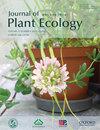Greater responses of flower phenology of Kobresia pygmaea community to precipitation addition than to constant and stepwise warming
IF 3.9
2区 环境科学与生态学
Q2 ECOLOGY
引用次数: 1
Abstract
There is a debate about unmatched results between manipulative warming using constant warming rates every year (CW) and long-term observations warming affect temperature sensitive of flowering phenology, and it is probable because that long-term observations could represent the actual yearly increase in temperature (i.e., a yearly stepwise warming rate per year, SW) which would differ from CW and their effects would be regulated by precipitation alteration. Here we conducted a warming experiment with CW (temperature increase by +1 ºC and sustained this elevated temperature for the duration of the study) and SW (temperature increase by + 0.25 ºC progressively each year) with precipitation addition in an alpine grassland for four years. Our results showed that neither warming rates affected community flowering phenology. However, precipitation addition advanced onsets of flowering for early-spring flowering (ESF) and mid-summer flowering (MSF) groups, and advanced the end date of flowering for ESF but delayed it for the MSF group. Thus, flowering duration remained stable for the ESF group and was prolonged for the MSF group, and further prolonged the flowering duration of the community. There were no interactions between warming rates and precipitation addition on the community flowering phenology. A severe drought in a year significantly decreased the maximum number of community flowers the following year. Therefore, change in precipitation has a greater effect than warming on the community flowering phenology in the semi-arid alpine grassland.矮嵩草群落对降水增加的响应大于对持续和逐步变暖的响应
关于使用每年恒定升温速率(CW)的控制升温和长期观测之间的不匹配结果,存在着争论,这是可能的,因为长期观测可以代表温度的实际年增长(即每年的逐步升温速度,SW),这将不同于CW,并且它们的影响将由降水变化调节。在这里,我们在高山草原上用CW(温度增加+1ºC,并在研究期间保持这种升高的温度)和SW(温度每年逐渐增加+0.25ºC)进行了四年的增温实验,并增加了降水量。我们的研究结果表明,这两种升温速率都不影响群落的花期。然而,降水增加提前了早春开花(ESF)和仲夏开花(MSF)组的开花期,并且提前了ESF组的开花结束日期,但推迟了MSF组的开花终止日期。因此,ESF组的花期保持稳定,MSF组的花期延长,并进一步延长了群落的花期。增温率和降水量对群落开花的影响不存在交互作用。一年中的严重干旱显著减少了第二年群落花卉的最大数量。因此,降水的变化对半干旱高寒草原群落花期的影响大于变暖。
本文章由计算机程序翻译,如有差异,请以英文原文为准。
求助全文
约1分钟内获得全文
求助全文
来源期刊

Journal of Plant Ecology
生物-植物科学
CiteScore
4.60
自引率
18.50%
发文量
134
审稿时长
3 months
期刊介绍:
Journal of Plant Ecology (JPE) serves as an important medium for ecologists to present research findings and discuss challenging issues in the broad field of plants and their interactions with biotic and abiotic environment. The JPE will cover all aspects of plant ecology, including plant ecophysiology, population ecology, community ecology, ecosystem ecology and landscape ecology as well as conservation ecology, evolutionary ecology, and theoretical ecology.
 求助内容:
求助内容: 应助结果提醒方式:
应助结果提醒方式:


